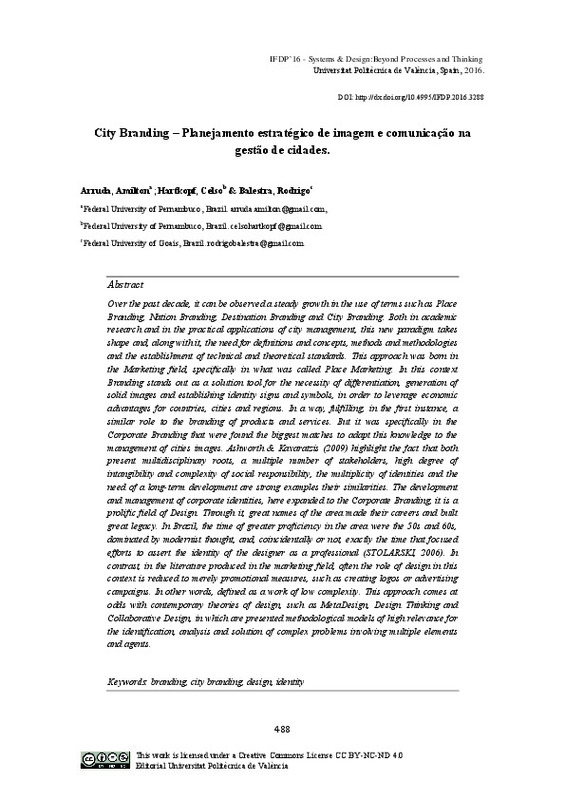JavaScript is disabled for your browser. Some features of this site may not work without it.
Buscar en RiuNet
Listar
Mi cuenta
Estadísticas
Ayuda RiuNet
Admin. UPV
City branding: strategic planning and communication image in the management of contemporary cities
Mostrar el registro sencillo del ítem
Ficheros en el ítem
| dc.contributor.author | Arruda, Amilton
|
es_ES |
| dc.contributor.author | Hartkopf, Celso
|
es_ES |
| dc.contributor.author | Balestra, Rodrigo
|
es_ES |
| dc.date.accessioned | 2017-09-20T06:39:43Z | |
| dc.date.available | 2017-09-20T06:39:43Z | |
| dc.date.issued | 2016-10-27 | |
| dc.identifier.isbn | 9788490484401 | |
| dc.identifier.uri | http://hdl.handle.net/10251/87559 | |
| dc.description.abstract | [EN] Over the past decade, it can be observed a steady growth in the use of terms such as Place Branding, Nation Branding, Destination Branding and City Branding. Both in academic research and in the practical applications of city management, this new paradigm takes shape and, along with it, the need for definitions and concepts, methods and methodologies and the establishment of technical and theoretical standards. This approach was born in the Marketing field, specifically in what was called Place Marketing. In this context Branding stands out as a solution tool for the necessity of differentiation, generation of solid images and establishing identity signs and symbols, in order to leverage economic advantages for countries, cities and regions. In a way, fulfilling, in the first instance, a similar role to the branding of products and services. But it was specifically in the Corporate Branding that were found the biggest matches to adapt this knowledge to the management of cities images. Ashworth & Kavaratzis (2009) highlight the fact that both present multidisciplinary roots, a multiple number of stakeholders, high degree of intangibility and complexity of social responsibility, the multiplicity of identities and the need of a long-term development are strong examples their similarities. The development and management of corporate identities, here expanded to the Corporate Branding, it is a prolific field of Design. Through it, great names of the area made their careers and built great legacy. In Brazil, the time of greater proficiency in the area were the 50s and 60s, dominated by modernist thought, and, coincidentally or not, exactly the time that focused efforts to assert the identity of the designer as a professional (STOLARSKI, 2006). In contrast, in the literature produced in the marketing field, often the role of design in this context is reduced to merely promotional measures, such as creating logos or advertising campaigns. In other words, defined as a work of low complexity. This approach comes at odds with contemporary theories of design, such as MetaDesign, Design Thinking and Collaborative Design, in which are presented methodological models of high relevance for the identification, analysis and solution of complex problems involving multiple elements and agents. | es_ES |
| dc.format.extent | 11 | es_ES |
| dc.language | Inglés | es_ES |
| dc.publisher | Editorial Universitat Politècnica de València | es_ES |
| dc.relation.ispartof | Systems&design:beyond processes and thinking | es_ES |
| dc.rights | Reconocimiento - No comercial - Sin obra derivada (by-nc-nd) | es_ES |
| dc.subject | Branding | es_ES |
| dc.subject | City branding | es_ES |
| dc.subject | Design | es_ES |
| dc.subject | Identity | es_ES |
| dc.title | City branding: strategic planning and communication image in the management of contemporary cities | es_ES |
| dc.type | Capítulo de libro | es_ES |
| dc.type | Comunicación en congreso | es_ES |
| dc.identifier.doi | 10.4995/IFDP.2015.3288 | |
| dc.rights.accessRights | Abierto | es_ES |
| dc.description.bibliographicCitation | Arruda, A.; Hartkopf, C.; Balestra, R. (2016). City branding: strategic planning and communication image in the management of contemporary cities. En Systems&design:beyond processes and thinking. Editorial Universitat Politècnica de València. 488-498. https://doi.org/10.4995/IFDP.2015.3288 | es_ES |
| dc.description.accrualMethod | OCS | es_ES |
| dc.relation.conferencename | Systems & Design: Beyond Processes and Thinking | es_ES |
| dc.relation.conferencedate | June 22-24,2016 | es_ES |
| dc.relation.conferenceplace | Valencia, Spain | es_ES |
| dc.relation.publisherversion | http://ocs.editorial.upv.es/index.php/IFDP/IFDP/paper/view/3288 | es_ES |
| dc.description.upvformatpinicio | 488 | es_ES |
| dc.description.upvformatpfin | 498 | es_ES |
| dc.type.version | info:eu-repo/semantics/publishedVersion | es_ES |
| dc.relation.pasarela | OCS\3288 | es_ES |








